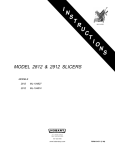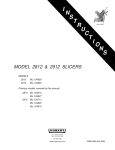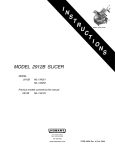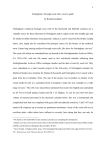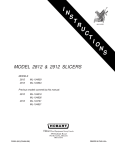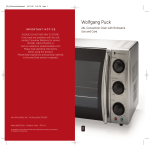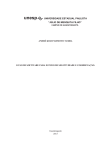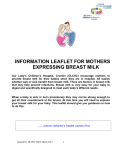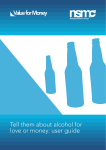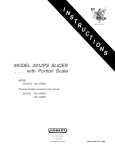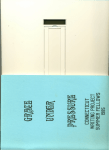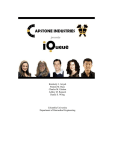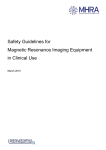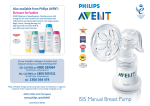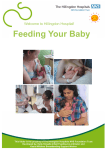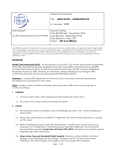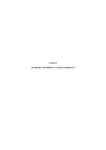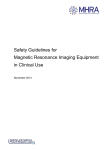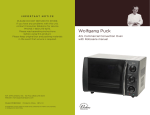Download Feeding twins, triplets and more Feeding twins, triplets and more
Transcript
Feeding twins, triplets and more A booklet for parents with advice and information Contents Introduction to this booklet...................................................................................... 4 1. The different feeding options.................................................................................... 5 Feeding twins, triplets and more A booklet for parents with advice and information This booklet is a guide only - all babies are different and will have individual needs and requirements. The information contained in this booklet should be used in conjunction with advice from health care professionals such as your health visitor, midwife or breastfeeding advisor. You may also contact the Multiple Births Foundation on 020 3313 3519 or [email protected] for more personal advice. Written by Jane Denton, Director, Multiple Births Foundation Maria Quigley, Reader in Statistical Epidemiology, National Perinatal Epidemiology Unit Biddy Ridley, Trustee, Multiple Births Foundation 2. Breastfeeding............................................................................................................ 6 3. Expressing breastmilk............................................................................................. 15 4. Feeding sick or premature babies........................................................................... 18 5. Feeding triplets and quads...................................................................................... 21 6. Formula feeding...................................................................................................... 22 7. Sterilisation and preparation of feeding equipment . ............................................ 24 and formula milk 8. Going back to work................................................................................................ 27 9. Introducing solid foods........................................................................................... 28 10. Support groups and useful organisations................................................................ 30 First published in 2011 by: The Multiple Births Foundation, Hammersmith House, Level 4, Queen Charlotte’s & Chelsea Hospital, Du Cane Road, London W12 0HS Tel: 020 3313 3519 Fax: 020 8383 3041 Email: [email protected] Website: www.multiplebirths.org.uk Registered Charity no: 1094546 Limited Company No: 4426289 Copyright © 2011 Multiple Births Foundation All rights reserved. No part of this publication may be reproduced, stored in a retrieval system or transmitted in any form or by any means, electronic, mechanical, photocopying, recording or otherwise, without the prior written permission of the Multiple Births Foundation. Images by Gaby Jeffs www.magnetofilms.com Available from: The Multiple Births Foundation ISBN: 978-1-902068-17-6 Introduction How on earth am I going to feed more than one baby? This is probably one of the thoughts uppermost in your mind as you await the birth of twins, triplets or more. You’re quite right to think about it and to start gathering information and advice to help you plan ahead. Not only are the nutritional aspects important: there are also practical implications. 1. WHAT ARE THE OPTIONS? Breastfeeding Breastmilk is best for babies, and that includes multiples. Not only does breastfeeding provide all the nutrients your babies need; it also contains antibodies from you which help them fight infections. Colostrum, produced by the breasts during pregnancy and the first days after the babies are born, is thicker and richer than breastmilk and especially valuable to new-born babies. It contains proteins and antibodies from the mother which increase the babies’ own resistance to illness. However, you needn’t be anxious about this. While it’s obviously true that feeding two or more babies takes more time and organisation than feeding one, it should be just as enjoyable and fulfilling. It can be a family event too. Mothers of newborn babies often feel very isolated and their partners can feel shut out at a time when they want to get involved. With twins or more, there’s no risk of that. Your partner can be of real help, especially during the night, and so could your mother or sister or a close friend. Many twins and triplets are premature. Breastmilk is particularly good for them because it is more easily digested and tolerated than formula milk and helps the underdeveloped gut to mature. But these babies may not be able to breastfeed at first, so you may need to express your milk and have it fed to your baby(ies) through a fine tube which goes into their tummy, or by a bottle or cup. (We give you more information about expressing milk in Chapter 3 and about feeding sick or premature babies in Chapter 4.) This booklet aims to set your mind at rest. It should help to answer the many questions you may have before the birth as well as serving as a practical guide once your babies are born. Our aim is for you to feel confident about feeding and caring for your babies in whatever way you choose, so that you can enjoy them to the full. Giving your babies some breastmilk each day, even for a short time, is better than no breastmilk at all. Remember: whatever your worries or problems, the professionals - nurses, midwives, health visitors, breastfeeding counsellors and advisors - are there to help you. Don’t hesitate to ask! You may also contact the Multiple Births Foundation on 020 3313 3519 or [email protected] 564 Feeding options The next chapter of this booklet will describe the many ways of breastfeeding twins and how the supply of milk - always a worry for prospective mothers of more than one baby - actually increases in response to demand. Breastfeeding your babies for at least six months is recommended. However, there is no need to feel guilty or inadequate if you can’t or don’t want to do it. For a variety of personal, physical or medical reasons, some parents of twins, triplets and quads opt for: Formula feeding You might choose formula milk because you wish to share the task of feeding with others If both parents are involved, for instance, each baby will receive undivided attention. We deal with formula feeding - preparation of milk, feeding techniques and sterilisation of feeding equipment in Chapter 5. Some mothers opt for formula feeding from the word go, but others start to consider it because they have difficulties with breastfeeding or expressing milk. If you are having difficulties but would prefer to continue breastfeeding, read the next chapter before you give up - it might be possible to solve your problems. If you definitely want to stop, discuss it with your midwife, health visitor, breastfeeding counsellor or advisor. They can advise you about stopping gradually so that you don’t get a problem such as blocked ducts. Of course, there is a third option, used by many parents of multiples at some stage: Mixed feeding This is when you feed your babies using different combinations of breastfeeding, expressed milk and formula milk. This allows the advantages of breastmilk to be combined with the advantages of others being able to help with feeding. 556 Breastfeeding 2. BREASTFEEDING It is perfectly possible to breastfeed twins, triplets and even quads. There are many different ways to do it. In this chapter, we answer some of your questions. How do I get started? Breastfeeding is a skill that needs to be learnt. Most mothers, even if they’ve only got one baby, need support and advice from professionals to help them get going. As the mother of twins or more, you should be offered extra help, both in hospital and once you are back at home. It usually takes about 4 to 6 weeks to get breastfeeding fully established, though some mothers may manage it sooner. Some newborns are easier to feed than others and there may well be a difference between your babies but don’t give up on a baby who seems “difficult”! It is usually best to let feeding be babyled (“on demand”) in the first few weeks. But, with more than one baby, it’s often wise to adapt your approach so that you don’t spend your whole time feeding and can get more rest. This means that you feed the baby who wakes first, and then wake the second one afterwards so that feed times are kept together. As your milk supply increases, the length of time between feeds should get longer and a pattern or routine which suits you and the babies will emerge. 6 Can I produce enough milk to feed my babies? Should I feed them together or separately? Mothers can produce enough milk to feed not just twins but even triplets and quads. That’s because milk is produced according to supply and demand - the more you breastfeed or express, the more milk you will produce. So if you feed your babies as often as they want and for as long as they want to begin with, you will produce enough milk for them. Mothers of twins have the option of feeding their babies simultaneously with one baby attached to each breast at the same time - or separately. Some mothers prefer feeding them together while others prefer to feed one after the other. Some mothers start off one way and change to the other. If your babies are too small or ill to breastfeed and you have to give them expressed breastmilk, it is still valuable to have direct skin to skin contact with them where possible. Not only does this help you bond with them; it also stimulates your milk production. For the first few days, it is usually advisable to feed one baby at a time at the breast, until you are confident about your feeding technique. This is especially true if they are your first babies. After that, opinions vary. Sometimes, a mother’s milk supply is temporarily reduced. This may be because of a complication at delivery or, more often, because of exhaustion, stress or anxiety. If that happens, don’t hesitate to ask other people for help so that you can concentrate on feeding and resting - it might just be for a couple of days, until your milk supply is established again. One way a partner or friend can help is to cook and do housework for you: it’s important to have a good diet of regular meals and to drink plenty of fluids. This will help you feel less tired and enable you to cope better with any stress or worries. Some mothers prefer simultaneous feeding because: A reduction in milk supply may also occur if you are not breastfeeding or expressing frequently enough. If your breasts still feel full after feeding your babies, then express any excess milk and ask for professional help to check the baby’s position at the breast when feeding. • If your babies are good at latching on and suckling, it is relatively easy. • It saves time and gives you more time to rest - especially at night, when you want to get back to sleep. • If one of your babies has a “stronger suck” than the other, that baby will stimulate the “let-down reflex”, which means that the other baby gets more milk with little effort. • Babies may respond positively to their brother or sister feeding at the same time as they are not distracted by them doing something else. Some mothers prefer separate feeding because: • It allows you to give one-to-one attention to each baby - something mothers of twins often feel they have very little time for. • It is generally easier, since you have both hands free to attach and position the baby and, once attached, you have a spare hand to rock the other baby, cuddle another child, hold a drink or phone, etc. • Some women feel more comfortable and less conspicuous feeding one baby rather than two, especially in public places. • Every baby feeds differently and you will learn the best position for each of your babies. What you do may change over time. You might start off one way and then change to the other as the babies get bigger or you have more or less help. Or you may feed them together in particular circumstances, such as when two babies are crying at the same time or you want to feed them in a shorter time, such as at night. If you think you might want to feed them together at some stage, it’s a good idea to try it when a midwife, nurse or breastfeeding counsellor is around to help you try different positions and provide an extra pair of hands. 7 Should I sit or lie for breastfeeding? And how do I support my back? Some suggested positions for simultaneous breastfeeding Most mothers of multiples find it easiest to sit in a chair, at least during the day. Identify a comfortable chair and put the phone, a drink and something to eat within easy reach - you may be sitting there for some time. Several commonly used positions are shown on the facing page. Remember: there are no rules on how to do this. Try different positions and do whatever is comfortable for you and your babies. You may find that one position works really well to begin with, but you find another position works better a few weeks later, for example, as the babies grow or when your tummy stops feeling tender. Try using pillows and cushions. You may need extra pillows to support your back when you start breastfeeding. It is also helpful to position pillows on your knees to take the weight of the babies. Some mothers find a V- or U-shaped special feeding cushion helpful, while others prefer to use additional ordinary pillows. The pillows should support the babies, allowing you to move your hands freely. Take care not to make them too high as the baby may not be able to attach correctly to the breast. You may find it easier to feed your baby(ies) when lying down, particularly if you are feeling tired, ill, or have had a caesarean section. Some mothers prefer to feed lying down so that they can, for instance, feed one baby while cuddling the other. Even when you are confident that your babies are breastfeeding happily, you may still need someone to help you, at least in the early days - for instance, to pass the second baby to you when you are feeding both at once, or to look after the other baby(ies) when they are fed separately. 8 Both in hospital and once you are back home, don’t forget to ask for professional help. As well as hospital and community staff, you may also find the organisations listed in Chapter 10 helpful. Again, ask a midwife, health visitor or a breastfeeding counsellor to help you try these positions. Try to involve your partner or any family support you have, so that they can help when there are no health professionals around. Double underarm hold Cradle hold Double cradle or criss-cross hold V-shaped hold See pictures on facing page. Same side or swap sides? In general, it’s better to alternate breasts when feeding multiples as each breast may have a different milk production and storage capacity. This ensures each breast receives equal stimulation from all babies. It also allows additional healing time if your nipples become sore. If your babies have very different birth weights or growth patterns then they are unlikely to have similar breastfeeding patterns and techniques. You and your babies will find the feeding pattern that works for you. It would only be necessary to change this if you have a problem or any of your babies are not growing well. 9 Baby-led (demand) feeding and other feeding patterns To establish a good milk supply, breast stimulation needs to be frequent. Therefore, breastfeeding needs to be unrestricted and/or expression needs to be frequent. This is particularly important in the early days. You should generally feed a baby when he or she shows readiness for a feed. (This is called baby-led feeding although many mothers still refer to it as “feeding on demand”). Typical feeding cues are a baby beginning to stir, or making mouthing and licking movements. It helps to look out for these feeding cues and start feeding before your baby gets upset. However, if your baby has slept for a very long time in the early days or if your breasts are engorged, it is a good idea to wake your baby and encourage feeding. • Sore breasts and nipples Sometimes the nipples become cracked or painful. Ask for help and advice on how to position your babies correctly. Different cushions or pillows may help. If you are expressing milk then ask for professional help to check your technique. In the first days after birth, you may find it easier to feed your babies separately, according to each baby’s feeding cues - in other words, for feeding to be completely baby-led. But many mothers of multiples find it easier to use a modified baby-led approach. Here, whichever baby wakens (or “demands” to be fed) first, is fed first. Then the second baby is gently awakened and fed individually, so that the mother has a reasonable interval until the next feed. The main drawback to this approach is that the awakened baby may be difficult to arouse and may not feed so well, although most babies usually get into this pattern fairly quickly. • Engorgement This is when the breasts become too full and are hard and painful. Placing warm flannels on your breasts before a feed can help or it may help if you express the excess milk (see Chapter 3). You will probably find it helpful to establish some kind of pattern as soon as possible. This may include a specific type of feeding pattern (such as “modified baby-led” feeding) or other feeding task (such as expressing milk after a particular feed or at a certain time), or getting help from others (such as someone else feeding or occupying one baby whilst you feed the other). Preventing and resolving breastfeeding problems 10 • Breastfeeding is uncomfortable Make sure that you are sitting or lying comfortably before you start feeding, as poor posture can cause backache. If you have backache or breastfeeding is not comfortable then try feeding in a different position. Sometimes problems arise with breastfeeding. Once again, don’t hesitate to ask for professional help - the quicker you sort out these problems, the better for you and your babies. Most difficulties can be solved with small adjustments, such as a change in the baby’s position at the breast. • Mastitis and blocked ducts If you have a hard, red painful lump on your breast then this is probably a blocked duct. This can be caused by a blockage in the duct and may be solved by checking your babies positioning and attachment. Placing warm flannels on the breasts before a feed can help and so can gentle massage. You should continue to feed as often as possible from the affected breast. Try to massage the lump while you feed. If the breast is not fully emptied after a feed then express the excess milk, but be careful not to over express the breast as your milk supply will increase and this can cause more problems. In addition some form of pain-killer may help relieve the discomfort, (ask for professional advice about which one would be most suitable for you). You should also check that your bra isn’t too tight and try to wear loose clothing. If your breasts feel hot and tender you may have an inflammation called mastitis. Mastitis can also be a sign of infection so if you feel hot, have a temperature and flu-like symptoms, and if there is no improvement within 12-24 hours, you should get advice from a healthcare professional. • Breastfeeding after a caesarean section If your babies were delivered by caesarean then you may not be very mobile to begin with and will possibly need help picking up the babies and positioning them at feed times. Your tummy will feel sore and painful for the first few days. It is advisable to feed the babies separately using the underarm method, which avoids the babies lying on your tummy. If you are breastfeeding your babies together, you will find the double underarm hold (see page 9) helpful. • If you are exhausted or breastfeeding takes too long It is vital for mothers of multiples to get plenty of rest, especially during the early days. This is particularly important if you are breastfeeding a well-rested mother is more able to cope with the demands of establishing breastfeeding in multiples. If the babies are not satisfied at each feed, they will require more frequent feeds. This can become a vicious cycle as the mother has even less time to rest, and becomes even more exhausted. Family members may pressure you to introduce a bottle at this point, so that you can get some sleep. If you are 11 keen to continue with breastfeeding then it is not advisable to do this, since less breastfeeding would further reduce your milk supply. A better strategy would be to concentrate on only feeding the babies as often as they require, then resting between feeds and eating a good diet. It may only take a couple of days for breastfeeding to be established again and for your energy levels to come back to normal. To prevent yourself becoming too exhausted, make sure that you have some sleep every night and take a daily rest. In the first month (at least), you should aim to have a day time rest or nap for at least a couple of hours every day. All sensible offers of help should be taken up so that this can happen. Are my babies getting enough milk? You can be sure your babies are getting enough milk if: • They stop feeding when they are full and then settle and sleep between feeds - they should be awake and alert for some of the time. • They have plenty of wet nappies each day - most babies have 6 to 8 wet nappies each day. 12 • They have normal stools - breastfed babies start off with meconium (which is dark green/brown/black and sticky) passed frequently and then will have frequent yellow stools by day 4 to 5. • They are gaining weight - talk to your health visitor about appropriate weight gain. Remember that all babies are different and have different feeding patterns. It is possible for two or more babies with completely different feeding patterns to each be getting the right amount of milk. This often happens with multiples. Don’t expect your babies to be the same, even if they are technically identical. It is more important to assess whether each baby is feeding sufficiently and growing adequately, rather than to assess how s/he is feeding and growing compared with his/her sibling. If you are unsure as to whether your babies are getting enough milk or you have any concerns about their growth then you should talk to your health visitor. Feeding multiples when there are older siblings around The birth of even one new baby may cause sibling rivalry. They are no longer the sole focus of their mother’s attention, as they suddenly find themselves having to compete with two or more other little people, whose care seems to take up every moment of the day. In order to gain attention, they may well resort to behaving badly at the most inconvenient moments such as feeding times. The box on the facing page includes some helpful tips for feeding multiples when there are older siblings around. Practical tips for feeding multiples when there are older siblings around: • A breastfeeding mother with an older child may find it more convenient to feed her babies separately, as she will still have a free arm for another child e.g. to read a story or reach out to the child. • Breastfeeding can be made into a positive time for other siblings e.g. it might signal story time, when a young sibling can crawl up beside the mother and have a story. • Fathers and other carers can help occupy the older child while the mother concentrates on feeding. • It may be helpful occasionally to invite a visitor specifically to give attention to the older sibling during a feeding time. • Depending on the age of the child, it may be possible to involve him or her with the babies’ care to some extent. Indeed, some sisters and brothers prove themselves absolutely invaluable. • Giving 5 minutes of the mother’s time now when an older child needs it may be more beneficial than giving them an hour when it is more convenient for you. A quick cuddle, setting up the favourite toy, starting them off doing homework, may occupy them sufficiently so that you can look after the babies. • Feeding time may signal the time for a treat such as being allowed to watch the TV or a DVD. 13 Breastfeeding multiples away from home Many mothers have anxieties about breastfeeding in public. For mothers of multiples, breastfeeding two or more babies in public may be an even more daunting prospect. However, with good preparation and planning, it is perfectly possible to breastfeed twins in public places. The box below includes some helpful tips: Practical tips for breastfeeding away from home • Nursing bras: You will need at least 3 or 4 well-fitting, comfortable nursing bras. • Clothing: You may be worried about revealing parts of your breasts and tummy in public. Wear clothes which provide easy and discreet access to the breasts. The babies’ clothes should allow easy nappy changing. • Separate versus simultaneous feeding: Some mothers prefer to breastfeed separately rather than simultaneously while out and about because it is more discreet. And it might be difficult to attach and position the babies for simultaneous feeding in a public place, without your usual chair, cushion, helpers, etc. • Breastfeeding-friendly places: Make a list of all the local places where breastfeeding is easy e.g. a particular café or infant/toddler group or a friend’s house. There are breastfeeding rooms in some supermarkets, department stores, etc. Try to plan trips out so that you are within easy reach of such places. • Going alone: Try to have someone with you until are confident about breastfeeding in a public place. When and how should I stop? The ideal is to breastfeed for at least six months. But if you want to stop earlier, for instance because you are going back to work or you have simply had enough, talk it over with a professional such as your health visitor or breastfeeding counsellor. Don’t worry: she won’t make you feel guilty. (Remember: any breastfeeding is better than none.) But she will be able to help you avoid problems, such as a blocked duct or mastitis that might arise if you stop too suddenly. 14 In general, once you have established a good milk supply, you need to reduce breastfeeding gradually. When the babies are less than six months old, the usual practice is to change one breastfeed for a formula feed per day and to allow the breasts to fully adjust before dropping another breastfeed. Expressing breastmilk 3. EXPRESSING BREAST MILK Why might I want to express my milk? Your babies are sick or premature One of the most common reasons for expressing your milk is because your babies are sick or premature and cannot breastfeed directly. Expressing your milk will provide breastmilk for your babies’ feeds. It will also establish and maintain your milk supply so that you will be producing enough milk when they are able to start breastfeeding directly. See the next chapter. To help relieve breastfeeding problems If your breasts feel full and uncomfortable (engorged) and the babies are having trouble attaching, then it might help to express a little milk before attempting to breastfeed. The milk should flow a bit easier then and the babies may find it easier to attach to a softer breast. Expressing can also help relieve a blocked duct or mastitis (see Chapter 2). To increase my milk supply Breastmilk is produced on a supply and demand basis - the more you express the more milk you will produce. If your babies only require small amounts of milk you still need to express fully to establish and maintain your milk supply. To allow other people to feed the babies You may want to express milk so that someone else can feed your babies. This may be something you do occasionally, for example, when you will be away from your babies for a few hours or longer. It may be something that you do regularly, for example, if you are returning to work. Remember that the best way of establishing or increasing your milk supply is to breastfeed, if your babies are able. There is no need to use expressing to establish a good milk supply in babies who are able to breastfeed directly - breastfeeding will establish a good milk supply. When learning to breastfeed When you and your babies are first learning to breastfeed, you may find it helpful to hand express a few drops of milk onto your nipple. This will encourage the baby to latch on, particularly if the baby is hungry and gets frustrated when your milk doesn’t flow from your nipple immediately. As a (long term) feeding strategy: Some mothers choose to (exclusively) feed their babies expressed breast milk rather than to breastfeed. Sometimes mothers choose to feed their babies expressed breast milk in combination with breast and/or formula feedings. This is particularly common in multiples, especially higher order multiples, so that other people can help with feeding. How to express There are several different ways to express your breastmilk and mothers often have their own preference: 15 • Hand expression - this is useful for expressing small amounts of milk from the breast for example, before the milk comes in when the babies are on the neonatal unit (NNU) and you need to collect the colostrum, when encouraging your baby to latch on, or for relieving uncomfortable breasts (see “Engorgement” and “Blocked ducts” in Chapter 2). • A manual breast pump - this is useful for occasional expressing or more regular or long-term expressing. Suction is created by squeezing a handle. Some mothers find this to be quite tiring if they are expressing for a long time. Make sure that the pump has the appropriate funnel size for your breasts, otherwise expressing may hurt or be less effective. • An electric or battery breast pump - this is useful for occasional expressing or more regular or long-term expressing. These can do simultaneous pumping of both breasts, if you wish. If your babies are in a neonatal unit, you will probably use a hospital-grade electric pump. Double pumping from both breasts at the same time is quicker than sequential pumping, so you may find that a double pump is useful for expressing over a long period of time. Again, make sure that the pump has the appropriate funnel size for your breasts, otherwise expressing may hurt or be less effective. Electric pumps can be bought or hired from manufacturers or other organisations such as the National Childbirth Trust (NCT). Staff on the unit should be able to give you this information. You should take care to ensure that all expressing equipment is sterilised after each pumping. How often to express If you are expressing to establish milk production while your babies are unable to breastfeed directly, then the first 2 weeks are really important in establishing the milk supply. Your milk production is likely to be increased if feeding and pumping are: • Initiated early - preferably within the first 6 hours after delivery. • Done regularly - approximately the same time each day or night. • Done frequently - every 2-3 hours during the day with a 4-6 hour break at night, or an average of 8 times per 24 hours. If your milk supply is already established and you are expressing as a longer term feeding strategy, then the number of times you need to express will depend on how often you will breastfeed. Expressing can be used to supplement breastfeeding. For example, you may breastfeed one baby directly and then give the other baby(ies) expressed breastmilk. If this is the case, it is better to breastfeed first and express afterwards. How to store expressed breastmilk Take care to sterilise all feeding and expressing equipment (see Chapter 7). When you express your breast milk, it must be stored in a fridge or freezer. Most of its antibodies and nutritional properties are not affected by refrigeration or freezing. So expressed breast milk is almost as good as direct breastfeeding. Expressed breastmilk must be stored under certain conditions: • For up to 5 days in the main part of a fridge, at 4°C or lower. • For up to 2 weeks in the freezer compartment of a fridge. • For up to 6 months in a domestic freezer, at minus 18°C or lower. • If you wish to store expressed breastmilk for less than 5 days, then the fridge preserves its properties more effectively than freezing. • Frozen breastmilk should be thawed in a fridge or using lukewarm water. Once thawed, use within 24 hours and never re-freeze. • Store expressed breastmilk in labelled bottles. 16 • Care should be taken to sterilise all feeding and expressing equipment (see Chapter 7). 17 Feeding sick or premature babies 4. FEEDING SICK OR PREMATURE BABIES How will my babies be fed? Babies who are sick or born prematurely may have special nutritional needs. In some babies, milk feeding may have to be delayed for a short period after they are born and the babies may receive only total parenteral nutrition (TPN) through an intravenous infusion (drip). Once milk feeding starts, it may be done through a thin tube that either goes via the nose (nasogastric) or mouth (orogastric) into the stomach. Ideally, this milk will be the mother’s expressed breast milk, although if this is not available then donor breastmilk or formula may be used. Sometimes expressed breast milk is fortified with protein, energy, vitamins and minerals, to help promote growth in the preterm baby. Helpful information The following booklet gives information about feeding premature babies. It describes the special feeding situations for sick and premature babies including skin-to-skin contact, how to express your milk, how to breastfeed, and how to continue feeding after discharge from hospital. The booklet is called: Introduction About half of all twins and most sets of triplets and quads are born prematurely. Some are born just a few weeks early but others may be born very prematurely. It is not uncommon for babies from multiple pregnancies to be admitted to a neonatal unit. This can be a particularly stressful time for parents. Some babies will be too premature or sick to breastfeed directly, but it is still possible to give them expressed breast milk. It is particularly important that these premature or sick babies receive breast milk rather than formula, as it is more easily digested by their immature gut and can help to protect them from infections and other illnesses. 18 If you are unable to express enough breast milk then your babies may be offered donor breast milk. This is breast milk which has been donated by a healthy mother who has been screened for various infections and her milk pasteurised. Premature babies who are fed donor breast milk are less likely to get NEC (necrotising enterocolitis - a serious disease of the immature bowel) than those babies who are fed formula milk. Donor breast milk is also easier for them to digest than formula milk. Jones E, Spencer A. Breastfeeding your premature baby. Bliss - the premature baby charity, 6th Edition 2009. It may be downloaded free of charge from the Bliss website www.bliss.org.uk The Bliss booklet provides much of the information you need about feeding premature babies. But there are some extra points to consider when you have more than one sick or premature baby. First, if you have more than one baby in the neonatal unit (NNU), then it is likely to be even more stressful for you as parents. Second, your babies may be at different stages of establishing feeding, or have different complications or illnesses. For example, it is not unusual for multiples to have very different birth weights. Your babies may even be in different places, for example one may be in the neonatal unit and one on the ward or at home with you. In fact, you may have two, three or four very different babies and their feeding pattern or ability to breastfeed may be very different too. Try to think of them as individuals rather than comparing them with each other. The practical advice on the following page may be helpful: 19 • Look after yourself. Try to eat healthy and regular meals, drink plenty of fluids and rest whenever you get the chance. • Try to spend as much time as possible with each of the babies, especially if one is in a neonatal unit and one on the ward with you. • Try having skin to skin contact with your babies. This may also be called kangaroo care and involves direct skin to skin contact with the baby lying on the mother’s chest. It can be done with all babies including those who are sick or premature. It will help facilitate milk production and help stop your babies crying. Skin to skin contact with multiples may be done separately, one after the other or at the same time. Ask the midwives or nurses how to do this. Skin to skin contact may also be done with fathers and other family members - but that obviously doesn’t produce the breastfeeding- related advantages! 20 are many support groups and other organisations who may be able to advise on feeding and other aspects of caring for your babies. These are listed at the end of the booklet. • Deciding which baby gets your milk. If there isn’t enough of your expressed breast milk to feed all of your babies, the staff on the neonatal unit will help you decide which baby receives it (e.g. the sickest) or whether it should be given to a different baby at each feed. • Express or breastfeed often. This will establish a good milk supply and enable you to have enough milk to breastfeed your babies. If you are very worried about your babies it can affect your milk production. • A step-by-step process towards direct breastfeeding. For sick and premature babies, there is often a gradual steady progress towards direct breastfeeding. There are several techniques for doing this, depending on the needs of your babies and the methods that are preferred in the hospital. For example, it may include using cups and/or bottles for feeding. The midwives and nurses will help you with this. Your babies may start breastfeeding at different times. If only one of your babies can breastfeed, then that baby can be fed on one or both sides, after which both breasts can be pumped to provide milk for the other baby(ies). • It is important to ask for help. Your partner, family and friends can be very supportive at this difficult time. It may help to talk through your feelings with them. They may also provide practical support such as helping organise the home for the babies’ arrival or help look after siblings or with domestic duties. The midwives and nurses can help you with skin to skin contact, expressing, breastfeeding and anything else in the hospital. There • Discharge planning. The midwives or nurses on the neonatal unit will help you work out a good feeding routine that suits you and your babies before their discharge so you can gradually get your babies into this routine before you go home. By the time your babies are ready for discharge you should feel confident with your feeding plan. If one baby is ready to go home before the other(s) then this will be incorporated into your feeding plan. Feeding Triplets and Quads 5. FEEDING TRIPLETS AND QUADS Much of what has been written in the previous and coming chapters applies to triplets and quads. This chapter summarises some of the key issues in feeding higher order multiples, together with some practical advice. Breastfeeding: • You will need help with night feeds, and also with housework, cooking, shopping, etc, so that you can put all your available time and energy into feeding. • It is a good idea to draw up a rota of who is available to help and when, before the babies are born. • Breastfeeding triplets - there are many ways to breastfeed triplets depending on what suits the mother and the babies. For example, mothers can breastfeed one after another, breastfeed two together and then one on their own, or breastfeed two and give expressed milk or formula to the third. • Breastfeeding quads - again there are many ways to feed quads depending on what suits you and the babies. One approach is to feed them approximately every 4 hours i.e. two together every two hours. • The babies will need more milk during growth spurts and this will be a tiring time for you while your milk supply adjusts, especially if all the babies have growth spurts together. However, this will settle down after a couple of days. Formula feeding: • The formula used will depend on whether the babies are born prematurely and if so whether they are in hospital or at home (see Chapter 6), the hospital will advise you. Combinations: • Mothers of triplets and quads who want to breastfeed may choose to use a combination of breast and formula milk. When considering different feeding options for triplets and quads, remember to take the following into account: Records and diaries • It might be useful for you or your partner to write down details of every feed, at least in the early days e.g. which baby was breastfed (and on which side, for how long) or how much expressed milk or formula was given. If you are using bottles you may also want to colour code them. This will enable you and the health professionals advising you to make sure that all of the babies are being fed adequately and ensure that the feeding methods for the babies are rotated where appropriate (e.g. breastfed for one feed and bottle fed for the next). Parents may find this particularly useful for the night feeds, when both parents are exhausted and it’s easy to forget who got what. Expressed breastmilk: Storage • Some women find that they prefer to breastfeed two babies while someone else can give expressed breastmilk or formula to the other baby(ies). • Remember: for babies receiving expressed breastmilk or formula in bottles, a lot of bottles and fridge space will be required! 21 Formula Feeding 6. FORMULA FEEDING Type of formula milk If your babies are in special care, and donor breast milk is not available and maternal breast milk is not available in sufficient quantities, then your babies will be given formula milk. There are a range of formulas available to meet the special needs of sick and premature babies. The hospital staff will advise you about these. If your babies are not sick or premature then standard formula milk will be appropriate. Simultaneous versus separate formula feeding Introduction This chapter refers to formula feeding. The preparation of formula milk and the sterilisation of feeding equipment are covered in Chapter 7 and should be read first. If you are combining breastfeeding and formula feeding, you should read the earlier sections on breastfeeding and expressing breast milk too. You may choose to feed your babies formula milk for a variety of personal, physical or medical reasons. You might be choosing formula milk because you wish to share the task of feeding with others. If both parents are involved with feeding then each baby will receive undivided attention from both parents. Two issues you should bear in mind are: • Making up formula feeds “fresh for each feed” (as currently recommended by the Department of Health) rather than several hours in advance may require careful co-ordination and help from somebody else. 22 • If your babies are being fed at the same time (particularly triplets and quads), the bottles, cups, etc, should be clearly labelled for each baby. This enables the mother to keep a record of how much each baby takes. If you have help it is generally recommended that your babies are fed separately so as to maximise the interaction with the carer. If both (all) your babies wake together, it is possible to feed two babies at once using one of the following positions: • Older babies may be positioned in an infant seat and you can sit near both of them, holding a bottle in each hand. • You can prop one baby in an infant seat or support pillow and hold one baby in your lap, again holding a bottle in each hand. Bottle propping should be avoided and a baby should never be left alone with a bottle. Hands-free feeding systems should not be used. The tubes are narrow and hard to clean properly. It is important that you (or the person doing the feeding) holds the bottle. If the babies are left alone to feed themselves they could choke. Different people helping with feeding If more than one person is involved in feeding the babies, it is generally recommended that babies are rotated between these people, so that there is interaction and stimulation between each baby-adult pair. Exhaustion Feeding multiples is a time-consuming experience whether the babies are breastfed or formula fed. The mother particularly will need help and support: • One way is to let someone else help with feeding or preparation of formula. • The father (or anyone else) may be able to help with night time feeding. For example, it is possible for both mother and father to have periods of uninterrupted sleep e.g. the mother can feed both (all) babies at the first night time feed while the father sleeps, and then the father can handle the second night time feed by himself. 23 Preparation of Feeding Equipment 7. STERILISATION AND PREPARATION OF FEEDING EQUIPMENT Introduction Guidance for Preparing Feeds in the Home • Re-assemble the bottle following manufacturer’s instructions. This chapter covers the sterilisation and preparation of all feeding equipment, including bottles, teats, cups, and breast pumps. It also includes the preparation of formula milk. Preparing a feed using powdered infant formula: • Shake the bottle well to mix the contents. Important: Normally each bottle should be made up fresh for each feed. Storing made-up formula milk may increase the chance of a baby becoming ill and should be avoided. • Cool quickly to feeding temperature by holding under a running tap, or placing in a container of cold water. In recent years, the recommendations on how to prepare formula milk have changed. What is recommended now may be different to what you or friends or relatives did for previous babies. Infant formula powders are not sterile. Therefore, water boiled at a higher temperature than previously thought is required. Feeds should now be made just before feeding rather than making up a whole 24 hours’ worth of feeds. The following advice on cleaning and sterilising feeding equipment and preparing formula milk is taken from the Department of Health for England’s current guidance, which is available at: http://www.dh.gov.uk/en/Publicationsandstatistics/Publications/ PublicationsPolicyAndGuidance/DH_100887 Cleaning and sterilising feeding equipment: • It is very important that all equipment used for feeding and preparing feeds has been thoroughly cleaned and sterilised before use. • Wash hands thoroughly before cleaning and sterilising feeding equipment. • Wash feeding and preparation equipment thoroughly in hot soapy water. Bottle and teat brushes should be used to scrub inside and outside of bottles and teats to ensure that all the remaining feed is removed. • After washing feeding equipment rinse it thoroughly under the tap. 24 • If using a commercial steriliser, follow manufacturer’s instructions. • If your bottles are suitable for sterilising by boiling: fill a large pan with water and completely submerge all feeding equipment, ensuring there are no air bubbles trapped; cover the pan and boil for at least 10 minutes, making sure the pan does not boil dry. Keep the pan covered until equipment is needed. • Wash hands thoroughly and clean the surface around the steriliser before removing equipment. • It is best to remove the bottles just before they are used. • If the bottles are not being used immediately, they should be fully assembled with the teat and lid in place to prevent the inside of the sterilised bottle and the inside and outside of the teat from being contaminated. • Clean the surface thoroughly on which to prepare the feed. • Wash hands with soap and water and then dry. • Boil fresh tap water in a kettle. Alternatively bottled water that is suitable for infants can be used for making up feeds and should be boiled in the same way as tap water. • Important: Allow the boiled water to cool to no less than 70º C. This means in practice using water that has been left, covered, for less than 30 minutes after boiling. • Pour the amount of boiled water required into the sterilised bottle. • Add the exact amount of formula as instructed on the label always using the scoop provided with the powdered formula by the manufacturer. Adding more or less powder than instructed could make the baby ill. • Check the temperature by shaking a few drops onto the inside of your wrist - it should feel lukewarm, not hot. • Discard any feed that has not been used within two hours. The following Questions and Answers are also copied from the Department of Health’s guidance and may help to answer your questions: Question and Answers What is the safest option for feeding babies? Breastmilk is the safest way to feed a baby. Ready to use liquid feeds are sterile until opened and are the safest option if using infant formula. Powdered infant formula is not sterile and should be made using water that is hotter than 70° C. Continued overleaf 25 Why is powdered infant formula not sterile? The bacterium enterobacter sakazakii is ubiquitous in the environment and may contaminate powdered infant formula during manufacture. It is impossible to be sure of avoiding this contamination. Bacteria may also be present on work surfaces in homes and nurseries and can contaminate feeds while they are being prepared by parents or carers. Why should the water be 70° C? Water at 70° C will kill most of the bacteria present in the powdered formula. This is the most important step in making up powdered infant formula as powdered infant formula cannot be guaranteed to be free of bacteria. Why should made up formula be cooled quickly? Bacteria multiply most quickly between 7 and 63° C. The longer formula is at this temperature, the greater the increase in the bacterial content and so the risk of infection for the baby will increase. 26 Why should storage times of made up formula be minimised? Even when formula is made up with water at more than 70° C it may still contain some bacteria which will continue to multiply during storage. At less than 5° C the rate of multiplication of the bacteria will reduce but will not completely cease. How long can made up formula be stored in a fridge? Made up formula can be stored for a maximum of 24 hours but this is no longer considered ideal particularly for young babies because the bacterial content continues to increase during storage. This increases the risk of infection for the baby. Going back to work 8. GOING BACK TO WORK If you want to return to work and carry on breastfeeding, you can do it - but it needs careful planning. Here are some helpful tips: Keep supplies of expressed breastmilk in the freezer Once a feed is ready for feeding, how long before it should be discarded? Discard any feed that has not been used within 2 hours. All left-over feed should be discarded and never saved for later. Before going back to work, you can build up supplies which can be fed to your babies during the day, while you’re at work. This store of breastmilk could be from when you had too much milk or from choosing to express so that you could feel confident you were still giving your babies the best when you returned to work. If you are out and cannot boil water how do you make up a feed? Mothers should be advised to fill a vacuum flask with boiling water. If the flask is full and sealed the water will stay above 70° C for several hours. This flask can be safely transported and used to make up a feed when necessary. Prepare your babies Do vacuum flasks need to be sterilised if they are used to store boiled water for making up a feed later? No, the vacuum flasks do not need to be sterilised but they should be washed thoroughly and rinsed with boiling water before being filled with boiling water intended for the feed. The boiling water should kill bacteria present in the vacuum flask. If water is boiled and put into the sterilised feeding bottles, can it be stored in the fridge like this until the powder is added? No, the water must be above 70° C when the powder is added, otherwise the bacteria in the powder will not be killed. It’s a good idea to introduce the occasional bottle in plenty of time before you go back to work so that the babies get used to feeding from a bottle. Make sure replacement feeders are fully informed Carer(s) who are feeding the babies your milk need to know the rules for storing expressed breastmilk or making up formula and sterilisation. They also need to know of any issues specific to feeding multiples: twins may have their own labelled bottles and may have different feeding patterns. Expressing at work If you want to express at work, your employer must find a suitable room and allow you sufficient time to do it. Your employer should be aware that expressing for multiples will probably take longer and require more equipment (bottles, storage space) than for singletons. Breastfeeding before and after work Many working mothers breastfeed directly before going to work in the morning and in the evening on their return, although other patterns suit other working mothers (for instance, some mothers may work night shifts). Your health visitor or breastfeeding counsellor can give advice about this. This needs careful timing: you will need to allow enough time to feed the babies and get them, yourself and any older children ready for the day before going to work. 27 Introducing solid foods (weaning) 9. INTRODUCING SOLID FOODS (WEANING) “Weaning” is the word used to describe the introduction of foods other than milk into a baby’s diet. Most people refer to it as “introducing solids”. When should it start? How to introduce solids The literal definition of the term weaning is “to accustom to”. When it is used to refer to the process of transferring from an all-milk diet to a mixed diet, it suggests a gradual process not: “all milk today, none tomorrow”. In general, parents may find the period of weaning quite stressful as they are responsible not just for the amount of nutrition their infant receives, but also for the balance of foods. Although nutrition is a science, feeding should be a pleasurable experience for all parties so you should apply a relaxed interpretation of the available evidence. As ever, use your common sense. If you are in any doubt about when to wean your babies or how to do it, ask your health visitor for advice. In addition, you can get excellent information on weaning from the Department of Health for England at: http://www.dh.gov.uk/en/Publicationsandstatistics/Publications/ PublicationsPolicyAndGuidance/DH_4117080 At around six months both breastfed and formula fed babies will be ready for solids to be introduced to their diet. It’s better to rely on your judgement rather than a rigid age rule to determine if your babies are ready to start solid foods. There are a number of cues that show babies are ready for weaning and we list them in the box below. They are not essential indicators and they should not be considered as cues if they occur before 4 months (17 weeks) of age in full-term babies or 5 months (21 weeks) in babies born prematurely. Signs that your babies are ready for solids (Remember: assess each baby separately) and in Scotland at: http://www.healthscotland.com/uploads/documents/8807-FunFirst%20 FoodsEnglish.pdf If your babies were premature your health visitor will be able to give you advice about when to start to introduce solids. Information relating specifically to preterm infants is available on the Bliss website - the charity for premature and sick babies - where a booklet can be downloaded: http://www.bliss.org.uk/page.asp?section=584§ionTitle=Weaning+ your+premature+baby • When the baby can sit up. • When the baby wants to chew and is putting toys and other objects in his/her mouth. • When the baby reaches and grabs accurately. (Taken from the Department of Health information leaflet “Weaning”) 28 29 Support Groups & Useful Organisations 10. SUPPORT GROUPS AND USEFUL ORGANISATIONS 30 Multiple Births Organisations Contact details Multiple Births Foundation (MBF) Address: Hammersmith House, Level 4, Queen Charlotte’s & Chelsea Hospital, Du Cane Road, London W12 0HS Phone: 020 3313 3519 Email: [email protected] Website: www.multiplebirths.org.uk Twins and Multiple Births Association (Tamba) Address: 2 The Willows, Gardner Road, Guildford, Surrey GU1 4PG Phone: 0870 770 3305 Email: [email protected] Website: www.tamba.org.uk Tamba Twinline (Helpline): 0800 138 0509 (10am -1pm, 7pm -10pm every day) Breastfeeding Support Groups Contact details Association of Breastfeeding Mothers Address: PO Box 207, Bridgewater TA6 7YT Phone (Helpline): 08444 122 949 (open 9.30am -10.30pm every day) Email: [email protected] Website: www.abm.me.uk Baby Friendly Initiative (UNICEF UK Baby Friendly Initiative) Address: 30a Great Sutton Street, London EC1V 0DU Phone: 020 7375 6052 Email: [email protected] Website: www.babyfriendly.org.uk Breastfeeding Network Address: PO Box 11126, Paisley PA2 8YB Phone (General): 0844 412 4664 Phone (Helpline): 0300 100 0210 Email: [email protected] Website: www.breastfeedingnetwork.org.uk La Leche League (Great Britain) Address: PO Box 29, West Bridgford, Nottingham NG2 7NP. Phone (General): 0845 456 1855 Phone (Helpline): 0845 120 2918 Website: www.laleche.org.uk National Breastfeeding Helpline Phone (Helpline): 0844 20 909 20 Website: www.breastfeeding.nhs.uk The National Breastfeeding Helpline is a helpline run in collaboration with the Breastfeeding Network (BfN) and the Association of Breastfeeding Mothers (ABM). National Childbirth Trust (NCT) Address: Alexandra House, Oldham Terrace, London W3 6NH Phone (General): 0300 3300770 Phone (Helpline): 0300 330 0771 (8am -10 pm, 7 days per week) Email: [email protected] Website: www.nct.org.uk United Kingdom Association for Milk Banking (UKAMB) Address: The Milk Bank, Queen Charlotte’s & Chelsea Hospital, Du Cane Road, London W12 0HS Phone: 020 8383 3559 Email: [email protected] Website: www.ukamb.org Other Useful Organisations Contact details Bliss (The special care baby charity) Address: 9 Holyrood Street, London Bridge, London SE1 2EL Phone: 020 7 378 1122 Phone (Helpline): 0500 618 140 (Helpline hours are 9am - 9pm) Email: [email protected] Website: www.bliss.org.uk Homestart UK Address: 2 Salisbury Road, Leicester LE1 7QR Phone: 0800 068 6368 Email: [email protected] Website: www.home-start.org.uk 31 Feeding Twins, Triplets and More A booklet for parents with advice and information www.multiplebirths.org.uk Registered Charity no: 1094546

















